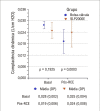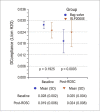Use of a Portable Mechanical Ventilator during Cardiopulmonary Resuscitation is Feasible, Improves Respiratory Parameters, and Prevents the Decrease of Dynamic Lung Compliance
- PMID: 37585896
- PMCID: PMC10382150
- DOI: 10.36660/abc.20220564
Use of a Portable Mechanical Ventilator during Cardiopulmonary Resuscitation is Feasible, Improves Respiratory Parameters, and Prevents the Decrease of Dynamic Lung Compliance
Abstract
Background: For practical and protective ventilation during cardiopulmonary resuscitation (CPR), a 150-grams mechanical ventilator (VLP2000E) that limits peak inspiratory pressure (PIP) during simultaneous ventilation with chest compressions was developed.
Objectives: To evaluate the feasibility of VLP2000E ventilation during CPR and to compare monitored parameters versus bag-valve ventilation.
Methods: A randomized experimental study with 10 intubated pigs per group. After seven minutes of ventricular fibrillation, 2-minute CPR cycles were delivered. All animals were placed on VLP2000E after achieving return of spontaneous circulation (ROSC).
Results: Bag-valve and VLP2000E groups had similar ROSC rate (60% vs. 50%, respectively) and arterial oxygen saturation in most CPR cycles, different baseline tidal volume [0.764 (0.068) vs. 0.591 (0.123) L, p = 0.0309, respectively] and, in 14 cycles, different PIP [52 (9) vs. 39 (5) cm H2O, respectively], tidal volume [0.635 (0.172) vs. 0.306 (0.129) L], ETCO2[14 (8) vs. 27 (9) mm Hg], and peak inspiratory flow [0.878 (0.234) vs. 0.533 (0.105) L/s], all p < 0.0001. Dynamic lung compliance (≥ 0.025 L/cm H2O) decreased after ROSC in bag-valve group but was maintained in VLP2000E group [0.019 (0.006) vs. 0.024 (0.008) L/cm H2O, p = 0.0003].
Conclusions: VLP2000E ventilation during CPR is feasible and equivalent to bag-valve ventilation in ROSC rate and arterial oxygen saturation. It produces better respiratory parameters, with lower airway pressure and tidal volume. VLP2000E ventilation also prevents the significant decrease of dynamic lung compliance observed after bag-valve ventilation. Further preclinical studies confirming these findings would be interesting.
Fundamentos: Para ventilação prática e protetora durante a ressuscitação cardiopulmonar (RCP), desenvolveu-se um ventilador mecânico (VLP2000E) de 150 gramas que limita o pico de pressão inspiratória (PPI) durante ventilação e compressões torácicas simultâneas.
Objetivos: Avaliar a viabilidade da ventilação com VLP2000E durante RCP e comparar os parâmetros monitorados versus ventilação com bolsa-válvula.
Métodos: Estudo experimental randomizado com 10 porcos intubados por grupo. Após sete minutos de fibrilação ventricular, iniciaram-se ciclos de RCP de 2 minutos. Todos os animais foram ventilados com VLP2000E após o retorno da circulação espontânea (RCE).
Resultados: Os grupos bolsa-válvula e VLP2000E apresentaram taxa de RCE (60% vs. 50%, respectivamente) e saturação arterial de oxigênio similares na maioria dos ciclos de RCP, volume corrente basal diferente [0,764 (0,068) vs. 0,591 (0,123) L, p = 0,0309, respectivamente] e, em 14 ciclos, diferentes PPI [52 (9) vs. 39 (5) cm H2O, respectivamente], volume corrente [0,635 (0,172) vs. 0,306 (0,129) L], ETCO2 [14 (8) vs. 27 (9) mm Hg], e pico de fluxo inspiratório [0,878 (0,234) vs. 0,533 (0,105) L/s], todos p < 0,0001. A complacência pulmonar dinâmica (≥ 0,025 L/cm H2O) diminuiu após o RCE no grupo bolsa-válvula, mas se manteve no grupo VLP2000E [ 0,019 (0,006) vs. 0,024 (0,008) L/cm H2O, p = 0,0003].
Conclusões: Ventilação com VLP2000E durante RCP é viável e equivalente a ventilação com bolsa-válvula quanto à taxa de RCE e saturação arterial de oxigênio. Esse ventilador produz melhores parâmetros respiratórios, com pressão das vias aéreas e volume corrente menores. Ventilação com VLP2000E também previne a redução significante da complacência pulmonar dinâmica observada após ventilação com bolsa-válvula. Seria interessante realizar mais estudos pré-clínicos para confirmar esses resultados.
Conflict of interest statement
Potencial conflito de interesse
Não há conflito com o presente artigo
Figures










Comment in
-
Ventilation and Respiratory Parameters in CPR: Where are We and Next Steps!Arq Bras Cardiol. 2023 Sep 18;120(7):e20230492. doi: 10.36660/abc.20230492. eCollection 2023. Arq Bras Cardiol. 2023. PMID: 37729334 Free PMC article. English, Portuguese. No abstract available.
Similar articles
-
[Experimental study on effect of airway pressure on cardiopulmonary resuscitation].Zhonghua Wei Zhong Bing Ji Jiu Yi Xue. 2017 Jun;29(6):531-535. doi: 10.3760/cma.j.issn.2095-4352.2017.06.011. Zhonghua Wei Zhong Bing Ji Jiu Yi Xue. 2017. PMID: 28625243 Chinese.
-
The effects of mechanical versus bag-valve ventilation on gas exchange during cardiopulmonary resuscitation in emergency department patients: A randomized controlled trial (CPR-VENT).Resuscitation. 2023 Dec;193:109966. doi: 10.1016/j.resuscitation.2023.109966. Epub 2023 Sep 12. Resuscitation. 2023. PMID: 37709163 Clinical Trial.
-
[Study of setting of ventilator volume tidal and airway pressure alarm threshold with continuous extra-sternum heart compression in cardiopulmonary resuscitation].Zhonghua Wei Zhong Bing Ji Jiu Yi Xue. 2013 Feb;25(2):102-5. doi: 10.3760/cma.j.issn.2095-4352.2013.02.013. Zhonghua Wei Zhong Bing Ji Jiu Yi Xue. 2013. PMID: 23648162 Clinical Trial. Chinese.
-
[Ventilation during cardiopulmonary resuscitation (CPR). A literature study and analysis of ventilation strategies].Anaesthesist. 1997 Feb;46(2):133-41. doi: 10.1007/s001010050383. Anaesthesist. 1997. PMID: 9133175 Review. German.
-
Effects of inspired gas content during respiratory arrest and cardiopulmonary resuscitation.Crit Care Med. 2000 Nov;28(11 Suppl):N196-8. doi: 10.1097/00003246-200011001-00006. Crit Care Med. 2000. PMID: 11098945 Review.
Cited by
-
Ventilation and Respiratory Parameters in CPR: Where are We and Next Steps!Arq Bras Cardiol. 2023 Sep 18;120(7):e20230492. doi: 10.36660/abc.20230492. eCollection 2023. Arq Bras Cardiol. 2023. PMID: 37729334 Free PMC article. English, Portuguese. No abstract available.
References
-
- Acute Respiratory Distress Syndrome Network. Brower RG, Matthay MA, Morris A, Schoenfeld D, Thompson BT, Wheeler A. Ventilation with Lower Tidal Volumes as Compared with Traditional Tidal Volumes for Acute Lung Injury and the Acute Respiratory Distress Syndrome. N Engl J Med. 2000;342(18):1301–1308. doi: 10.1056/NEJM200005043421801. - DOI - PubMed
-
- Kill C, Hahn O, Dietz F, Neuhaus C, Schwarz S, Mahling R, et al. Mechanical Ventilation During Cardiopulmonary Resuscitation with Intermittent Positive-Pressure Ventilation, Bilevel Ventilation, Or Chest Compression Synchronized Ventilation in a Pig Model. Crit Care Med. 2014;42(2):e89–e95. doi: 10.1097/CCM.0b013e3182a63fa0. - DOI - PubMed
MeSH terms
LinkOut - more resources
Full Text Sources
Medical

